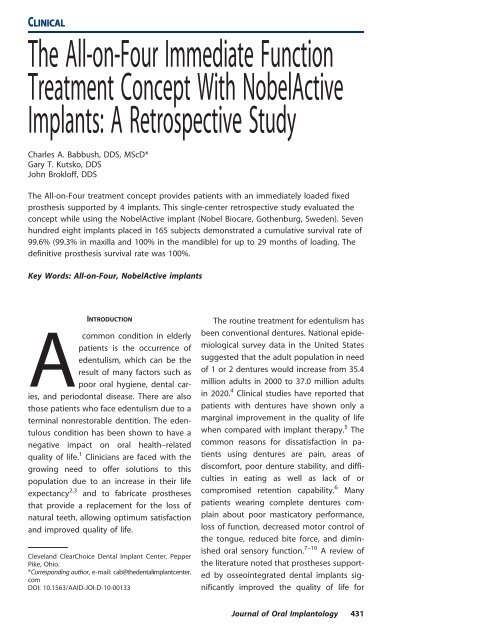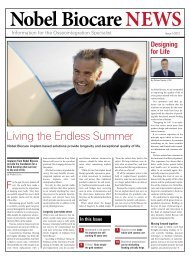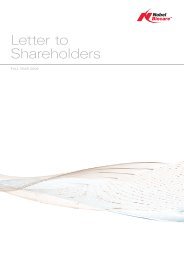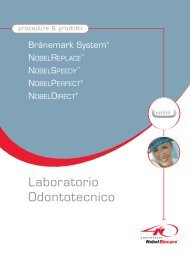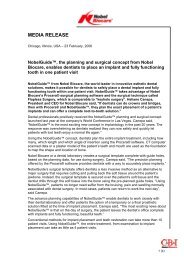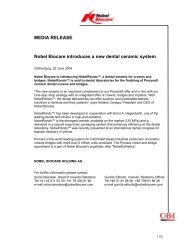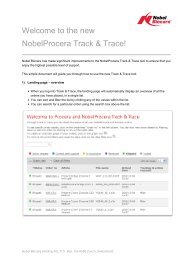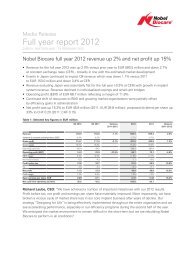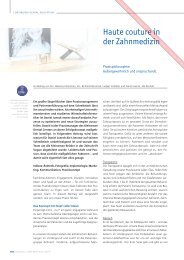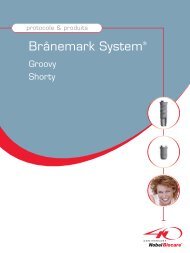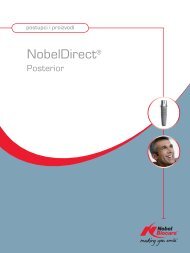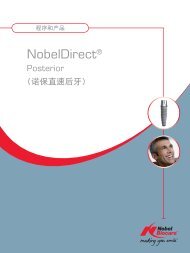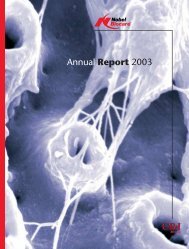clinical - Nobel Biocare
clinical - Nobel Biocare
clinical - Nobel Biocare
You also want an ePaper? Increase the reach of your titles
YUMPU automatically turns print PDFs into web optimized ePapers that Google loves.
CLINICAL<br />
The All-on-Four Immediate Function<br />
Treatment Concept With <strong>Nobel</strong>Active<br />
Implants: A Retrospective Study<br />
Charles A. Babbush, DDS, MScD*<br />
Gary T. Kutsko, DDS<br />
John Brokloff, DDS<br />
The All-on-Four treatment concept provides patients with an immediately loaded fixed<br />
prosthesis supported by 4 implants. This single-center retrospective study evaluated the<br />
concept while using the <strong>Nobel</strong>Active implant (<strong>Nobel</strong> <strong>Biocare</strong>, Gothenburg, Sweden). Seven<br />
hundred eight implants placed in 165 subjects demonstrated a cumulative survival rate of<br />
99.6% (99.3% in maxilla and 100% in the mandible) for up to 29 months of loading. The<br />
definitive prosthesis survival rate was 100%.<br />
Key Words: All-on-Four, <strong>Nobel</strong>Active implants<br />
INTRODUCTION<br />
Acommon condition in elderly<br />
patients is the occurrence of<br />
edentulism, which can be the<br />
result of many factors such as<br />
poor oral hygiene, dental caries,<br />
and periodontal disease. There are also<br />
those patients who face edentulism due to a<br />
terminal nonrestorable dentition. The edentulous<br />
condition has been shown to have a<br />
negative impact on oral health–related<br />
quality of life. 1 Clinicians are faced with the<br />
growing need to offer solutions to this<br />
population due to an increase in their life<br />
expectancy 2,3 and to fabricate prostheses<br />
that provide a replacement for the loss of<br />
natural teeth, allowing optimum satisfaction<br />
and improved quality of life.<br />
Cleveland ClearChoice Dental Implant Center, Pepper<br />
Pike, Ohio.<br />
*Corresponding author, e-mail: cab@thedentalimplantcenter.<br />
com<br />
DOI: 10.1563/AAID-JOI-D-10-00133<br />
The routine treatment for edentulism has<br />
been conventional dentures. National epidemiological<br />
survey data in the United States<br />
suggested that the adult population in need<br />
of 1 or 2 dentures would increase from 35.4<br />
million adults in 2000 to 37.0 million adults<br />
in 2020. 4 Clinical studies have reported that<br />
patients with dentures have shown only a<br />
marginal improvement in the quality of life<br />
when compared with implant therapy. 5 The<br />
common reasons for dissatisfaction in patients<br />
using dentures are pain, areas of<br />
discomfort, poor denture stability, and difficulties<br />
in eating as well as lack of or<br />
compromised retention capability. 6 Many<br />
patients wearing complete dentures complain<br />
about poor masticatory performance,<br />
loss of function, decreased motor control of<br />
the tongue, reduced bite force, and diminished<br />
oral sensory function. 7–10 A review of<br />
the literature noted that prostheses supported<br />
by osseointegrated dental implants significantly<br />
improved the quality of life for<br />
Journal of Oral Implantology 431
All-on-Four Immediate Function Treatment<br />
edentulous patients when compared with<br />
conventional dentures. 11–15<br />
Immediate loading of implant-supported,<br />
full-arch prostheses for these patients in the<br />
mandible or maxilla has been documented as<br />
a predictable procedure. 16–20 Excellent success<br />
rates for immediately loaded, fixed<br />
prosthetic reconstructions 19–26 and long-term<br />
follow-up results have been reported in the<br />
literature. 27–29 Immediate loading of implantsupported<br />
fixed full-arch prostheses for these<br />
cases in the edentulous maxilla and mandible<br />
has been associated with a high level of<br />
satisfaction for patients in terms of esthetics,<br />
phonetics, and functionality. 17–20,30–34<br />
Dental implants are traditionally placed in<br />
the vertical position. However, in the completely<br />
edentulous jaw as well as in the<br />
postextraction patient, problems such as<br />
minimum bone volume, poor bone quality,<br />
and the need for bone-grafting procedures<br />
prior to implant placement create some<br />
challenging conditions. For these situations,<br />
it has been demonstrated that distal tilting<br />
of implants may be advantageous. Tilting<br />
preserves relevant anatomical structures and<br />
allows for placement of longer implants with<br />
good cortical anchorage in optimal positions<br />
for prosthetic support. 35,36 Strain gauge<br />
measurements performed by Krekmanov<br />
reported no significant difference between<br />
tilted and nontilted implants, and theoretical<br />
models showed an increased prosthetic base<br />
due to the inclination of implants, which in<br />
turn can reduce the force acting over the<br />
implants. 36 Tilting also increases the interimplant<br />
space, reduces cantilever length in<br />
jaws, 21,31,36,37 and reduces the need for bone<br />
augmentation. Good <strong>clinical</strong> outcomes have<br />
been reported in various studies using tilted<br />
implants. 31,32,35,38–40<br />
The All-on-Four treatment concept provides<br />
edentulous arches and immediate/<br />
postextraction subjects with an immediately<br />
loaded, fixed prosthesis using 4 implants:<br />
2 axially oriented implants in the anterior<br />
432 Vol. XXXVII/No. Four/2011<br />
region and 2 tilted posterior implants. 31,32,37<br />
The principle involves the use of 4 implants<br />
restored with straight and angled multiunit<br />
abutments, which support a provisional,<br />
fixed, immediately loaded, full-arch prosthesis<br />
placed on the same day of surgery. The<br />
All-on-Four treatment has been developed<br />
to maximize the use of available bone and<br />
allows immediate function. Overall, published<br />
data on the All-on-Four concept<br />
reported cumulative survival rates between<br />
92.2% and 100%. 31–34,37,40–42<br />
The All-on-Four concept has been reported<br />
predominantly in the literature with the<br />
<strong>Nobel</strong>Speedy or the Branemark System<br />
dental implants. The purpose of this study<br />
was to evaluate the All-on-Four concept<br />
using an implant (<strong>Nobel</strong>Active) with a<br />
tapered body and a variable thread design<br />
for up to 29 months of loading.<br />
MATERIALS AND METHODS<br />
This is a retrospective single-center study.<br />
Subjects with totally edentulous arches and/<br />
or in need of extraction of the remaining<br />
compromised teeth were rehabilitated with<br />
the <strong>Nobel</strong>Active implants. The first implant in<br />
the study was placed on February 21, 2008,<br />
and the last implant was placed on September<br />
12, 2009. Each subject received an<br />
immediately loaded, fixed, complete-arch<br />
provisional prosthesis on the day of implant<br />
placement according to the All-on-Four<br />
technique. The definitive prostheses were<br />
delivered within 6 to 8 months after implant<br />
insertion. An actuarial life table method was<br />
used to determine implant cumulative survival<br />
rate.<br />
Patients treated with the technique and<br />
therefore included in the retrospective analysis<br />
met the following criteria:<br />
N jaw bone profile for the placement of at least<br />
4 implants of at least 10 mm in length in<br />
either healed or immediate extraction sites
N good general health with acceptable oral<br />
hygiene<br />
N implants achieved stability at insertion<br />
Patients could not be treated according to<br />
the technique if they had insufficient bone<br />
quality and quantity for placement of endosseous<br />
implants, exhibited severe parafunctional<br />
habits, or had a compromised medical<br />
history that would affect implant placement<br />
(eg, bisphophonates, chemotherapy).<br />
Surgical protocol<br />
A cone-beam computerized tomographic<br />
scan (CBCT; I-CAT cone beam CT scan,<br />
Imaging Science Corp, Hatfield, Penn) was<br />
taken prior to surgery, and the bone profile,<br />
which included the bone quality and bone<br />
volume, was assessed 43 by 2 experienced<br />
clinicians (C.A.B. and G.T.K.). In the vast<br />
majority of cases, the patient was administered<br />
intravenous (conscious) sedation using<br />
fentanyl citrate 0.5 mg/mL (fentanyl; Hospira,<br />
Lake Forest, Ill), diazepam 5 mg/mL injection<br />
(Valium; Hospira), as well as nitrous oxide<br />
oxygen inhalation. This was in addition to<br />
articaine hydrochloride 4% and epinephrine<br />
bitartrate 1:100 000 (Septodent, Paris, France),<br />
local anesthesia that was administered in<br />
both block and infiltration technique. A few<br />
of the patients were administered general<br />
anesthesia based their preexisting medical<br />
profile.<br />
Patients were started on a course of<br />
antibiotic (penicillin VK 250 mg, Dispensing<br />
Solutions, Santa Ana, Calif), 4 times a day,<br />
2 days prior to the surgical procedure in<br />
cases in which teeth had to be extracted.<br />
Postoperatively, all patients were given the<br />
same antibiotic 4 times per day over a period<br />
of 10 days. If patients were allergic to<br />
penicillin, clindamycin tablets (clindamycin<br />
HCL 150 mg, Dispensing Solutions) were<br />
given using a similar dosage regimen. In<br />
addition, hydrocodone bitartrate and acetaminophen<br />
7.5 mg/750 mg (Vicodin, Dis-<br />
pensing Solutions) were also used as an<br />
analgesic along with anti-inflammatory medication,<br />
methylprednisolone, 4-mg dose pack<br />
(Medrol, Dispensing Solutions). At the end of<br />
the procedure, bupivacaine 0.5% with<br />
1:200 000 epinephrine (bupivacaine, Cook-<br />
Waite, Greensboro, NC) was also administered<br />
for its analgesic-sparing effect.<br />
Implant placement<br />
Babbush et al<br />
<strong>Nobel</strong>Active implants were inserted by<br />
(C.A.B.) according to the manufacturer’s<br />
guidelines (manual No. 21279-GB085, <strong>Nobel</strong><br />
<strong>Biocare</strong> Services 2008). Each subject received<br />
2 distally tilted implants in the posterior<br />
region followed by 2 anterior implants in<br />
either the maxilla or the mandible. In the<br />
maxilla, the tilted implants were positioned<br />
just anterior to the maxillary sinus and in the<br />
mandible; the tilted implants were positioned<br />
anterior to the mental foramen.<br />
Implant placement was assisted by the Allon-Four<br />
surgical guide (<strong>Nobel</strong> <strong>Biocare</strong>; Figure<br />
4). The guide was placed into a 2-mm<br />
osteotomy made at the midline of the<br />
mandible and/or maxilla, and the titanium<br />
band was contoured so that the occlusal<br />
centerline of the opposing jaw was followed.<br />
The guide allowed for optimal positioning,<br />
alignment, parallelism, and inclination of the<br />
implants for subsequent anchorage and<br />
prosthetic support. The drill protocol followed<br />
the manufacturer’s guidelines (All-on-<br />
Four procedures and products, manual<br />
No. 16896 Lot GB 0603, <strong>Nobel</strong> <strong>Biocare</strong><br />
Services, 2006). The implant sites were<br />
usually underprepared avoiding countersinking<br />
to engage as maximum cortical support<br />
bone as possible. The recommended drill<br />
sequences for soft bone type IV, medium<br />
type II and type III, and dense type I bone<br />
were followed. A manual surgical torque<br />
wrench (<strong>Nobel</strong> <strong>Biocare</strong>) was used to check<br />
the final torque of the implant, which was<br />
carefully documented (Table 1). In cases of<br />
immediate implant placement, the soft<br />
Journal of Oral Implantology 433
All-on-Four Immediate Function Treatment<br />
tissues were readapted to obtain a primary<br />
closure around the abutments and fresh<br />
extraction sites and then sutured back into<br />
position with interrupted resorbable 4.0<br />
chromic sutures (Salvin Dental Specialties,<br />
Charlotte, NC). Local bone grafting to cover<br />
exposed threads and/or other osseous defects<br />
associated with extraction sockets was<br />
performed at 64% of implant sites with<br />
demineralized bone matrix gel (Dyna graft-<br />
D, Keystone Dental, Boston, Mass), and 1% of<br />
implant sites were grafted with autogenous<br />
bone from the local surgical area.<br />
Straight, 17u multiunit abutment, internal<br />
(<strong>Nobel</strong> <strong>Biocare</strong>), and 30u angulated multiunit<br />
abutments, internal (<strong>Nobel</strong> <strong>Biocare</strong>), were<br />
used to achieve relative parallelism of the<br />
implants so that a rigid prosthesis would<br />
seat in a passive manner.<br />
Open-tray multiunit impression copings<br />
(<strong>Nobel</strong> <strong>Biocare</strong>) were placed on the abutments,<br />
and an impression was made with a<br />
custom open tray using precision impression<br />
material (Flexitime, Heraeus Kulzer, Hanau,<br />
Germany). Patients were instructed to avoid<br />
brushing and to use warm water rinses for<br />
the first postoperative week. A cold or roomtemperature<br />
soft diet for the first 24 hours<br />
following surgery was recommended, followed<br />
by a semisolid diet for the next<br />
3 months. Patients were given antibiotics<br />
and analgesics as listed in the surgical<br />
protocol. A CBCT scan was taken immediately<br />
postoperatively to verify the implant<br />
positions and the prosthetic components.<br />
Prosthetic protocol<br />
A provisional denture was prefabricated with<br />
heat-cured acrylic resin (Ivocap high-impact<br />
acrylic, Ivoclar Vivadent, Schaan, Liechtenstein)<br />
prior to the surgical procedure. Immediately<br />
following surgery, the denture was<br />
modified to the master model in the<br />
laboratory. Fabrication was completed using<br />
cold-curing material (Probase, Ivoclar Vivadent).<br />
This provisional all-acrylic resin pros-<br />
434 Vol. XXXVII/No. Four/2011<br />
TABLE 1<br />
Torque values (implant insertion)<br />
Ncm n %<br />
,35 14 1.98<br />
35 40 5.65<br />
36–45 53 7.49<br />
46–55 41 5.79<br />
56–65 41 5.79<br />
66–70 471 66.53<br />
Not recorded* 48 6.78<br />
Total 708 100<br />
*Implants achieved primary stability, although<br />
torque was not noted in numerical values.<br />
thesis was seated within 3 to 4 hours of<br />
completion of surgery on the same day. The<br />
patients were scheduled for routine followup<br />
visits after surgery at 1 week, 2 weeks,<br />
4 weeks, and 3 months postoperative and on<br />
a yearly basis. At the 3-month appointment,<br />
fabrication of the definitive prosthesis was<br />
initiated.<br />
Periapical digital radiographs using a<br />
parallel technique were obtained at the 3month<br />
appointment and thereafter on a<br />
yearly basis from the date of the surgery<br />
(Figures 7, 13, 14, 20, and 29). Implants were<br />
checked by visual observation for plaque<br />
and bleeding on probing at the follow-up<br />
intervals. Periapical radiographs and plaque<br />
and bleeding indices at various follow-up<br />
intervals are part of routine care for patients<br />
at the clinic and not a part of the analysis in<br />
this study.<br />
The definitive prostheses consisted of a<br />
milled titanium frame with a wrap-around<br />
heat-cured acrylic resin (Ivocap high-impact<br />
acrylic). All restorations were performed by 1<br />
clinician (G.T.K.).<br />
Survival criteria<br />
The modified Albrektsson criteria used in this<br />
investigation are the following: an implant<br />
was regarded successful when there was (1)<br />
no radiolucency around the implant; (2) no<br />
signs of infection, pain, or ongoing pathological<br />
processes at the implant site; (3) the
implant was restored and functionally loaded;<br />
and (4) the prosthesis was stable for multiple<br />
implants supporting a complete arch prosthesis.<br />
An implant was classified surviving when it<br />
remained in the jaw and was functionally<br />
loaded even though all the individual success<br />
criteria were not fulfilled. A failed implant was<br />
an implant that had fractured beyond repair<br />
or could not be classified as a successful or<br />
surviving implant. 44<br />
Statistics<br />
A single reviewer abstracted the relevant<br />
data from medical records of the patients<br />
who were treated consecutively with the Allon-Four<br />
technique and entered them into a<br />
spreadsheet (Excel 2007, Microsoft, Redmond,<br />
Wash). An actuarial life table 45 was<br />
used to calculate the cumulative survival<br />
rate. Statistical analysis was done in SPSS<br />
17.0 (SSPS, Chicago, Ill) using the Fisher exact<br />
test to determine the level of significance<br />
(P , .05) comparing the survival rates of the<br />
arches as well as the various implant sizes.<br />
RESULTS<br />
One hundred sixty-five patients (72 men<br />
and 93 women) with a mean age of 59<br />
(SD 611 years) have been included in the<br />
analysis. Seven hundred eight implants restoring<br />
both jaws (109 maxillae and 68<br />
mandibles) have been placed. Four hundred<br />
thirty-six implants have been placed in the<br />
maxilla and 272 in the mandible. Twelve<br />
patients were treated in both jaws. Each<br />
prosthesis was supported by 4 implants. Most<br />
of the implants were seated with a minimum<br />
of 35-Ncm torque. Two percent (n 5 14) of<br />
the implants were seated at a torque of<br />
,35 Ncm (Table 1). All implants achieved<br />
primary stability at placement. Four hundred<br />
twenty-four implants were placed in extraction<br />
sites immediately after tooth extraction,<br />
and 284 were placed in healed sites. Local<br />
bone grafting was performed at 65% of the<br />
Position<br />
TABLE 2<br />
Implant placement<br />
Maxilla Mandible<br />
Total Number of Implants<br />
Central incisor<br />
Right 11 2<br />
Left<br />
Lateral incisor<br />
10 7<br />
Right 62 37<br />
Left<br />
Canine<br />
66 31<br />
Right 38 28<br />
Left<br />
First premolar<br />
39 31<br />
Right 14 16<br />
Left<br />
Second premolar<br />
14 6<br />
Right 77 45<br />
Left<br />
First molar<br />
72 51<br />
Right 15 7<br />
Left<br />
Second molar<br />
17 11<br />
Right 0 0<br />
Left<br />
Third molar<br />
1 0<br />
Right 0 0<br />
Left 0 0<br />
Total 436 272<br />
Babbush et al<br />
implant sites; no bone grafting was reported<br />
in 35% of the sites. Implant distribution<br />
according to implant type and implant length<br />
is outlined in Tables 2 and 3, respectively.<br />
Implant follow-up occurred up to 29 months.<br />
Acrylic provisional restorations were placed<br />
within 3 to 4 hours of surgery, with occlusal<br />
contact limited to the anterior area only.<br />
Two anterior implants failed in 2 different<br />
patients at the 1-month and 7-month time<br />
points due to mobility. In a third patient, 1<br />
tilted implant failed at the 4-month time<br />
point due to mobility. All 3 implants failed<br />
during the provisional prosthesis phase. All<br />
of the 3 implants have been replaced, and<br />
no further complications have been noted in<br />
these patients. None of the implant failures<br />
compromised the prosthesis function, and<br />
no relation was found between implant<br />
failure and the opposing dentition.<br />
Journal of Oral Implantology 435
All-on-Four Immediate Function Treatment<br />
Two patients aged 70 and 68 years were<br />
lost to follow-up at the 1-year and less than<br />
3-month visit. These patients passed away<br />
due to natural causes. Two additional<br />
patients were lost to follow-up at the 3month<br />
follow-up visit. Therefore, a total of 16<br />
implants have been lost to follow-up. One<br />
hundred sixty-two patients in the study have<br />
completed the 6-month follow-up and have<br />
had their definitive prostheses (174) delivered.<br />
Three jaws were lost to follow-up prior<br />
to definitive prosthetic delivery, and 1 jaw<br />
was lost to follow-up after definitive prosthetic<br />
delivery. One hundred fifty-six patients<br />
have completed the 1-year follow-up.<br />
The overall implant survival rate was<br />
99.6% (1 year; Table 4) with no significant<br />
TABLE 3<br />
Implant size (<strong>Nobel</strong>Active TiUnite)*<br />
Implant Diameter Implant Length, mm Maxillae Mandibles<br />
3.5 8.5 — —<br />
10 — —<br />
11.5 12 —<br />
13 31 9<br />
15 28 (1) 42<br />
4.3 8.5 — —<br />
10 2 2<br />
11.5 16 7<br />
13 84 18<br />
15 94 92<br />
18 4 1<br />
5.0 8.5 — —<br />
10 — —<br />
11.5 5 1<br />
13 20 15<br />
15 131 (2) 81<br />
18 9 4<br />
436 (3) 272<br />
*( ) indicates failed implants/replaced.<br />
TABLE 4<br />
Cumulative survival analysis*<br />
Placed/Followed<br />
Implants<br />
difference between the maxillae and mandibles<br />
(99.3% vs 100%, P 5 .06, Fisher exact<br />
test). The 4.3-mm-diameter implants were<br />
most frequently used, with a survival rate of<br />
100% (99.2% for 3.5 mm and 99.2% for<br />
5.0 mm; Figure 1). No total arch failures have<br />
occurred to date, providing a definitive<br />
prosthesis survival rate of 100%. The life<br />
table analysis demonstrating the cumulative<br />
survival rate is reported in Table 4.<br />
Figures 2 through 8 demonstrate a case in<br />
postextraction sites of the mandible and<br />
maxilla with immediate implant placement,<br />
Figures 9 through 14 show a case in healed<br />
sites of a patient with a severely atrophic<br />
edentulous maxilla. The patient has been<br />
edentulous for 50 years. Figures 15 through<br />
Failed<br />
Implants<br />
Time Not<br />
Passed<br />
Lost to<br />
Follow-up CSR<br />
Implant insertion »» 3 months 708 1 0 4 99.9<br />
3 months »» 6 months 703 1 0 8 99.7<br />
6 months »» 12 months 694 1 29 0 99.6<br />
12 months »» 18 months 664 0 336 4 99.6<br />
18 months »» 24 months 324 0 240 0 99.6<br />
»» 24 months 84 0<br />
*CSR indicates cumulative survival rate.<br />
436 Vol. XXXVII/No. Four/2011
FIGURE 1. Cumulative survival rate in relation to<br />
implant diameter.<br />
20 show a case displaying terminal nonrestorable<br />
dentition of the maxilla and mandible<br />
with extraction and immediate implant reconstruction,<br />
and Figures 21 through 29 show a<br />
case of a patient with an edentulous maxilla<br />
reconstructed with the All-on-Four technique.<br />
No complications were reported during<br />
surgery or immediately after surgery.<br />
DISCUSSION<br />
The overall survival rate was 99.6% (1 year),<br />
with no significant difference between the<br />
Babbush et al<br />
maxillae and mandibles. Three implants<br />
failed over a period of 29 months of loading.<br />
The prosthesis survival rate was 100%. This is<br />
in accordance with studies on biomechanical<br />
measurements, which demonstrated that<br />
tilted implants, when part of a prosthetic<br />
support, do not have a negative effect on<br />
the load distribution. 16,46,47 In addition, a<br />
biomechanical rationale in tilting distal<br />
implants allows a reduction in cantilever<br />
length due to the more posterior position of<br />
the tilted implants, resulting in a more<br />
favorable stress distribution. 47,48<br />
The methodology of using titled implants<br />
maximizing the use of the available bone<br />
without grafting has been reported, leading<br />
to successful <strong>clinical</strong> outcomes. 35,41,42 This is<br />
in comparison to the traditional implant<br />
treatment in which insufficient bone in the<br />
posterior region requires bone-grafting procedures<br />
involving greater chair time for the<br />
patient as well as increased cost and<br />
increased number of procedures.<br />
FIGURE 2. Case 1: maxillary and mandibular all-on-Four technique in extraction sites with immediate<br />
implant placement. Preoperative computerized tomography scan.<br />
Journal of Oral Implantology 437
All-on-Four Immediate Function Treatment<br />
FIGURES 3–8. Case 1: maxillary and mandibular All-on-Four technique in extraction sites with immediate<br />
implant placement. FIGURE 3. Extraction sockets in the mandible. FIGURE 4. All-on-Four surgical guide in<br />
situ. FIGURE 5. Implants in final position. FIGURE 6. Postoperative radiographs at 4 months. FIGURE 7.<br />
Clinical photograph of patient at 1 year. FIGURE 8. Postoperative radiographs at 1 year.<br />
The results of this study are comparable<br />
with studies of other implant systems using<br />
the All-on-Four concept in the maxilla. Maló et<br />
al 32 reported a high survival rate of 97.6% in a<br />
1-year retrospective study in which 128 Brane-<br />
438 Vol. XXXVII/No. Four/2011<br />
mark implants (<strong>Nobel</strong> <strong>Biocare</strong> AB, Goteborg,<br />
Sweden) were immediately loaded in 32<br />
patients. Each jaw received 2 axial and 2 distal<br />
implants (All-on-Four) supported by a fixed allacrylic<br />
prosthesis in the completely edentu-
Babbush et al<br />
FIGURE 9. Case 2: 50-year history of a severely atrophic edentulous maxilla reconstructed with the All-on-<br />
Four technique. Preoperative computerized tomography scan.<br />
FIGURES 10–14. Case 2: 50-year history of a severely atrophic edentulous maxilla reconstructed with the<br />
All-on-Four technique. FIGURE 10. Implants in final position. FIGURE 11. Fixed implant bridge removed to<br />
demonstrate soft-tissue health at 1 year. FIGURE 12. Clinical view at 1 year. FIGURE 13. Postoperative<br />
radiographs at 1 year demonstrating stable bone levels. FIGURE 14. Postoperative radiographs at 2 years<br />
demonstrating stable bone levels.<br />
Journal of Oral Implantology 439
All-on-Four Immediate Function Treatment<br />
FIGURES 15–17. Case 3: All-on-Four technique in maxillary and mandibular (nonrestorable dentition)<br />
extraction sites with immediate implant placement. FIGURE 15. Preoperative computerized tomography<br />
scan. FIGURE 16. (a, b, c) Preoperative <strong>clinical</strong> photographs of the terminal nonrestorable dentition.<br />
FIGURE 17. (a) Implants placed in maxilla with abutments and healing caps in position. (b) Implants<br />
placed in mandible with abutments and healing caps in position.<br />
lous maxilla. 32 Testori et al 42 reported a 98.8%<br />
implant survival and a 100% prosthetic<br />
survival rate using a different type of implant<br />
system, angulation of the implant-abutment<br />
connection for the tilted implants, and a<br />
different type of technique for the fabrication<br />
of the final prosthesis. In this prospective,<br />
multicenter center study, 41 patients received<br />
an immediately placed full-arch fixed bridge<br />
supported each by 4 axial and 2 distally tilted<br />
Ossesotite NT implants (3i, Implant Innovations,<br />
Palm Beach, Fla) in the edentulous<br />
maxillae. 42 Aparacio et al 35 reported a survival<br />
rate of 100% for tilted implants, 96.5% survival<br />
for axial implants, and a prosthetic survival<br />
440 Vol. XXXVII/No. Four/2011<br />
rate of 100% after 5 years when 101 Branemark<br />
implants were placed in the severely<br />
resorbed maxilla of 25 patients (59 axially<br />
placed and 42 in a tilted direction). Each<br />
patient received 2 to 5 implants with at least 1<br />
tilted implant. 35 Calandriello et al 38 reported a<br />
survival rate of 96.7% in a 1-year prospective<br />
<strong>clinical</strong> study when 60 MKIV and Replace<br />
select implants (<strong>Nobel</strong> <strong>Biocare</strong> AB) were<br />
placed in the atrophic maxilla of 18 patients.<br />
In this study, 12 partial- and 7 full-arch, fixed<br />
prostheses were supported by a total of 33<br />
axially placed and 27 tilted implants. 38<br />
The results of this study are in accordance<br />
with other studies reporting good
survival rates in the mandible. In a 1-year<br />
retrospective <strong>clinical</strong> study, Maló et al 31<br />
reported an implant survival of 96.7% and<br />
98.2% (2 groups) and a prosthetic survival<br />
rate of 100% when 176 Branemark implants<br />
were placed in 44 patients. An immediately<br />
loaded complete-arch all-acrylic prosthesis<br />
was supported by 4 implants (All-on-Four) in<br />
each completely edentulous mandible. 31<br />
Another study reported a 100% implant<br />
and prosthetic survival rate when 96 MKIV<br />
or the <strong>Nobel</strong>Speedy Groovy implants (<strong>Nobel</strong><br />
<strong>Biocare</strong> AB) were placed in 24 edentulous<br />
patients treated in the mandible according<br />
to the All-on-Four concept. 1 In addition, a<br />
100% implant survival and prosthetic survival<br />
rate was reported in a prospective study<br />
when 80 Branemark implants were placed in<br />
20 patients with a extremely atrophic<br />
mandible. Each patient received 2 axially<br />
Babbush et al<br />
FIGURES 18–20. FIGURE 18. Case 3: All-on-Four technique in maxillary and mandibular (nonrestorable<br />
dentition) extraction sites with immediate implant placement. Maxillary and mandibular immediate<br />
provisional fixed prosthesis in place. FIGURE 19. Postoperative panoramic radiograph at 4 months.<br />
FIGURE 20. Postoperative radiograph at 15 months demonstrating stable bone levels.<br />
placed and 2 tilted implants, supporting a<br />
fixed full-arch prosthesis (All-on-Four concept).<br />
40<br />
Previously published literature reporting<br />
survival rates using the All-on-Four concept<br />
in both the mandible and maxilla is similar to<br />
the results of this analysis. In a pilot study, a<br />
survival rate of 98.9% was reported in a case<br />
series when 189 <strong>Nobel</strong>Speedy implants were<br />
placed in 46 patients, supporting 53 fullarch,<br />
all-acrylic prostheses (44 maxillae, 9<br />
mandibles) using the All-on-Four concept. 33<br />
Maló et al 34 reported a survival rate of 97.2%<br />
and 100% in the maxilla and mandible in a 1year<br />
prospective study when 92 <strong>Nobel</strong>-<br />
Speedy implants were placed in 23 consecutively<br />
treated patients. Each jaw was<br />
restored by a immediate fixed full-arch<br />
prosthesis according to the All-on-Four<br />
concept. 34 Pomares 41<br />
reported a 96.9%<br />
Journal of Oral Implantology 441
All-on-Four Immediate Function Treatment<br />
FIGURES 21–25. Case 4: edentulous maxilla reconstructed with the All-on-Four technique. FIGURE 21.<br />
Preoperative <strong>clinical</strong> photograph. FIGURE 22. Preoperative <strong>clinical</strong> photograph of the edentulous maxilla.<br />
FIGURE 23. Preoperative panoramic radiograph demonstrating the edentulous maxilla. FIGURE 24. The<br />
abutments and premounted abutment holders adjusting for relative parallelism. FIGURE 25. (a) The final<br />
position of the implants, abutments, and healing caps. (b) The mucoperiosteal flaps repositioned and<br />
sutured with 4-0 chromic interrupted sutures.<br />
implant survival (96.7% in the maxilla and<br />
97.2% in the mandible) and a 100% prosthetic<br />
survival rate in a prospective study<br />
when 127 MKIII Groovy implants were placed<br />
in 20 patients (restoring 19 maxillae and<br />
9 mandibles) using the All-on-Four or Allon-Six<br />
concept. A survival rate of 98.4% and<br />
99.7% (maxilla and mandible) at the end of<br />
1 year was reported in another single-cohort<br />
study in which 173 edentulous patients<br />
received 2 distal and 2 anterior axial MKIV<br />
or <strong>Nobel</strong>Speedy Groovy implants. In this<br />
442 Vol. XXXVII/No. Four/2011<br />
study, each patient received a full-arch fixed<br />
prosthesis supported by 2 distal and 2 axial<br />
implants (All-on-Four). 49<br />
Other long-term studies using the concept<br />
are comparable to the data in this<br />
analysis. Implant survival rates from the<br />
follow-up of results of the previously mentioned<br />
studies from Maló et al 31,32 with a<br />
longer follow-up demonstrated a survival rate<br />
of 96.2% in the mandible up to 9 years and<br />
97.7% in the maxilla up to 5 years of followup.<br />
37 Citing the published literature, it was
noted that the overall cumulative survival rate<br />
of 99.6% (1 year) in this study for the new<br />
implant system (<strong>Nobel</strong>Active) while using the<br />
All-on-Four concept offers an attractive solution<br />
to clinicians treating edentulous and/or<br />
immediate extraction patients.<br />
CONCLUSION<br />
Babbush et al<br />
FIGURES 26–29. Case 4: edentulous maxilla reconstructed with the All-on-Four technique. FIGURE 26. (a, b)<br />
The tissue and occlusal views of the all-acrylic fixed provisional implant bridge. FIGURE 27. Postoperative<br />
panoramic radiograph taken immediately after implant placement. FIGURE 28. Clinical photograph with<br />
the definitive prosthesis in place. FIGURE 29. Postoperative radiographs at 1 year with the definitive fixed<br />
implant prosthesis in place.<br />
The overall survival rate using the All-on-<br />
Four immediate function treatment concept<br />
using an implant with a tapered body and a<br />
variable thread design can be considered a<br />
viable treatment concept for patients pre-<br />
Journal of Oral Implantology 443
All-on-Four Immediate Function Treatment<br />
senting with edentulous arches and/or<br />
immediate placement.<br />
NOTE<br />
Dr Babbush has a consulting agreement with<br />
<strong>Nobel</strong> <strong>Biocare</strong> AB Sweden for ongoing<br />
<strong>clinical</strong> studies and continuing education<br />
courses.<br />
REFERENCES<br />
1. Agliardi E, Clericò M, Ciancio P, Massironi D.<br />
Immediate loading of full-arch fixed prostheses supported<br />
by axial and tilted implants for the treatment of<br />
edentulous atrophic mandibles. Quintessence Int.<br />
2010;41:285–293.<br />
2. World Medical Association Declaration of Helsinki.<br />
Ethical principles for medical research involving<br />
human subjects. J Am Med Assoc. 2000;284:2043–3045.<br />
3. Salvin B. The business of implant dentistry. In:<br />
Babbush C, Hahn J, Krauser J, Rosenlicht J, eds. Dental<br />
Implants: The Art and Science. 2nd ed. St Louis, Mo:<br />
Saunders Elsevier; 2010:7–13.<br />
4. US Bureau of the Census. Statistical Abstract of<br />
the United States: 1996. 116th ed. Washington, DC: US<br />
Bureau of the Census; 1996:p 15, tables II, No. 16, p 17,<br />
table II, No. 17.<br />
5. Allen PF, McMillan AS. A review of the functional<br />
and psychosocial outcomes of edentulousness treated<br />
with complete replacement dentures. J Can Dent Assoc.<br />
2003;69(10):662.<br />
6. Heath MR. The effect of maximum biting force<br />
and bone loss upon masticatory function and dietary<br />
selection of the elderly. Int Dent J. 1982;32:345–356.<br />
7. Wolff A, Gadre A, Begleiter A, Moskona D,<br />
Cardash H. Correlation between patient satisfaction<br />
with complete dentures and denture quality, oral<br />
condition, and flow rate of submandibular/sublingual<br />
salivary glands. Int J Prosthodont. 2003;16:45–48.<br />
8. Ikebe K, Matsuda K, Morii K, Furuya-Yoshinaka M,<br />
Nokubi T, Renner RP. Association of masticatory<br />
performance with age, posterior occlusal contacts,<br />
occlusal force, and salivary flow in older adults. Int J<br />
Prosthodont. 2006;19:475–481.<br />
9. Koshino H, Hirai T, Ishijima T, Ikeda Y. Tongue<br />
motor skills and masticatory performance in adult<br />
dentates, elderly dentates, and complete denture<br />
wearers. J Prosthet Dent. 1997;77:147–152.<br />
10. Ikebe K, Amemiya M, Morii K, et al. Association<br />
between oral stereognostic ability and masticatory<br />
performance in aged complete denture wearers. Int J<br />
Prosthodont. 2007;20:245–250.<br />
11. Turkyilmaz I, Company AM, McGlumphy EA.<br />
Should edentulous patients be constrained to removable<br />
complete dentures? The use of dental implants to<br />
improve the quality of life for edentulous patients.<br />
Gerodontology. 2010;27(1):3–10.<br />
12. Allen F, McMillan A. Food selection and<br />
perceptions of chewing ability following provision of<br />
implant and conventional prostheses in complete<br />
444 Vol. XXXVII/No. Four/2011<br />
denture wearers. Clin Oral Implants Res. 2002;13:320–<br />
326.<br />
13. Awad MA, Lund JP, Dufresne E, Feine JS.<br />
Comparing the efficacy of mandibular implant-retained<br />
overdentures and conventional dentures among middle-aged<br />
edentulous patients: satisfaction and functional<br />
assessment. Int J Prosthodont. 2003;16:117–122.<br />
14. Awad MA, Lund JP, Shapiro SH, et al. Oral<br />
health status and treatment satisfaction with mandibular<br />
implant overdentures and conventional dentures: a<br />
randomized <strong>clinical</strong> trial in a senior population. Int J<br />
Prosthodont. 2003;16:390–396.<br />
15. Heydecke G, Thomason JM, Lund JP, Feine JS.<br />
The impact of conventional and implant supported<br />
prostheses on social and sexual activities in edentulous<br />
adults: results from a randomized trial 2 months after<br />
treatment. J Dent. 2005;33:649–657.<br />
16. Bellini CM, Romeo D, Galbusera F, et al.<br />
Comparison of tilted versus nontilted implant-supported<br />
prosthetic designs for the restoration of the<br />
edentuous mandible: a biomechanical study. Int J Oral<br />
Maxillofac Implants. 2009;24:511–517.<br />
17. Malo P, de Araujo Nobre M, Rangert B. Implants<br />
placed in immediate function in periodontally compromised<br />
sites: a five-year retrospective and one-year<br />
prospective study [published correction appears in J<br />
Prosthet Dent. 2008;99:167]. J Prosthet Dent. 2007;97(6<br />
suppl):S86–S95.<br />
18. Khatami AH, Smith CR. ‘‘All-on-Four’’ immediate<br />
function concept and <strong>clinical</strong> report of treatment of an<br />
edentulous mandible with a fixed complete denture<br />
and milled titanium framework. J Prosthodont. 2008;17:<br />
47–51.<br />
19. Ioannidou E, Doufex A. Does loading time<br />
affect implant survival? A meta analysis of 1,266<br />
implants. J Periodontol. 2005;76:1252–1258.<br />
20. Attard NJ, Zarb GA. Immediate and early<br />
implant loading protocols: a literature review of <strong>clinical</strong><br />
studies. J Prosthet Dent. 2005;3:242–258.<br />
21. Del Fabbro M, Bellini CM, Romeo D, Francetti L.<br />
Tilted implants for the rehabilitation of edentulous<br />
jaws: a systematic review. Clin Implant Dent Relat Res.<br />
Epub ahead of print, 13 May 2010.<br />
22. Nkenke E, Fenner M. Indications for immediate<br />
loading of implants and implant success. Clin Oral<br />
Implants Res. 2006;17(suppl 2):19–34.<br />
23. Avila G, Galindo P, Rios H, Wang HL. Immediate<br />
implant loading: current status from available literature.<br />
Implant Dent. 2007;16:235–245.<br />
24. Esposito M, Grusovin MG, Willings M, Coulthard<br />
P, Worthington HV. Interventions for replacing missing<br />
teeth: different times for loading dental implants.<br />
Cochrane Database Syst Rev. 2007;(2):CD003878.<br />
25. Jokstad A, Carr AB. What is the effect on<br />
outcomes of time-to-loading of a fixed or removable<br />
prosthesis placed on implant(s)? [published correction<br />
appears in Int J Oral Maxillofac Implants. 2008;23:56]. Int<br />
J Oral Maxillofac Implants. 2007;22(suppl):19–48.<br />
26. Sennerby L, Gottlow J. Clinical outcomes of<br />
immediate/early loading of dental implants: a literature<br />
review of recent controlled prospective <strong>clinical</strong> studies.<br />
Aust Dent J. 2008;53(suppl 1):S82–S88.<br />
27. Ericsson I, Randow K, Nilner K, Peterson A. Early<br />
functional loading of Bra˚nemark dental implants: 5-year<br />
<strong>clinical</strong> follow-up study. Clin Implant Dent Relat Res.<br />
2000;2(2):70–77.
28. Henry P, Rosenberg I. Single-stage surgery for<br />
rehabilitation of the edentulous mandible: preliminary<br />
results. Pract Periodontics Aesthet Dent. 1994;6(9):15–22.<br />
29. Schnitman PA, Wöhrle PS, Rubenstein JE,<br />
DaSilva JD, Wang NH. Ten-year results for Bra˚nemark<br />
implants immediately loaded with fixed prostheses at<br />
implant placement. Int J Oral Maxillofac Implants.<br />
1997;12:495–503.<br />
30. Rosenlicht J, Ward J, Krauser J. Immediate<br />
loading of dental implants In: Babbush C, Hahn J,<br />
Krauser J, Rosenlicht J, eds. Dental Implants: The Art and<br />
Science. 2nd ed. St Louis, Mo: Saunders Elsevier; 2010:<br />
343–345.<br />
31. Maló P, Rangert B, Nobre M. ‘‘All-on-Four’’<br />
immediate-function concept with Bra˚nemark system<br />
implants for completely edentulous mandibles: a<br />
retrospective <strong>clinical</strong> study. Clin Implant Dent Relat<br />
Res. 2003;5(suppl 1):2–9.<br />
32. Maló P, Rangert B, Nobre M. All-on-4 immediate-function<br />
concept with Bra˚nemark system implants<br />
for completely edentulous maxillae: a 1-year retrospective<br />
<strong>clinical</strong> study. Clin Implant Dent Relat Res.<br />
2005;7(suppl 1):S88–S94.<br />
33. Maló P, Nobre Mde A, Petersson U, Wigren S. A<br />
pilot study of complete edentulous rehabilitation with<br />
immediate function using a new implant design: case<br />
series. Clin Implant Dent Relat Res. 2006;8:223–232.<br />
34. Maló P, de Araujo Nobre M, Lopes A. The use of<br />
computer-guided flapless implant surgery and four<br />
implants placed in immediate function to support a<br />
fixed denture: preliminary results after a mean followup<br />
period of thirteen months [published correction<br />
appears in J Prosthet Dent. 2008;99:167]. J Prosthet Dent.<br />
2007;97(6 suppl):S26–34.<br />
35. Aparicio C, Perales P, Rangert B. Tilted implants<br />
as an alternative to maxillary sinus grafting: a <strong>clinical</strong>,<br />
radiologic, and periotest study. Clin Implant Dent Relat<br />
Res. 2001;3:39–49.<br />
36. Krekmanov L, Kahn M, Rangert B, Lindstrom H.<br />
Tilting of posterior mandibular and maxillary implants<br />
of improved prosthesis support. Int J Oral Maxillofac<br />
Implants. 2000;15:405–414.<br />
37. Malo P, Lopez I, Nobre M. The All on Four<br />
concept. In: Babbush C, Hahn J, Krauser J, eds. Dental<br />
Implants: The Art and Science. 2nd ed. St Louis, Mo:<br />
Saunders Elsevier; 2010:435.<br />
38. Calandriello R, Tomatis M. Simplified treatment<br />
of the atrophic posterior maxilla via immediate/early<br />
function and tilted implants: a prospective 1-year<br />
Babbush et al<br />
<strong>clinical</strong> study. Clin Implant Dent Relat Res. 2005;7(suppl<br />
1):S1–12.<br />
39. Fortin Y, Sullivan R, Rangert BR. The marius<br />
implant bridge: surgical and prosthetic rehabilitation<br />
for the completely edentulous upper jaw with moderate<br />
to severe resorption: a 5-year retrospective <strong>clinical</strong><br />
study. Clin Implant Dent Relat Res. 2002;4:69–77.<br />
40. Weinstein R, Agliardi E, Fabbro MD, Romeo D,<br />
Francetti L. Immediate rehabilitation of the extremely<br />
atrophic mandible with fixed full-prosthesis supported<br />
by four implants. Clin Implant Dent Relat Res. Epub<br />
ahead of print, 2010 Feb 11.<br />
41. Pomares C. A retrospective <strong>clinical</strong> study of<br />
edentulous patients rehabilitated according to the ‘‘all<br />
on four’’ or the ‘‘all on six’’ immediate function concept.<br />
Eur J Oral Implantol. 2009;2(1):55–60.<br />
42. Testori T, Del Fabbro M, Capelli M, Zuffetti F,<br />
Francetti L, Weinstein RL. Immediate occlusal loading<br />
and tilted implants for the rehabilitation of the atrophic<br />
edentulous maxilla: 1-year interim results of a multicenter<br />
prospective study. Clin Oral Implants Res.<br />
2008;19:227–232.<br />
43. Ganz S. Defining new paradigms for assessment<br />
of implant receptor sites: the All on Four concept.<br />
In: Babbush C, Hahn J, Krauser J, Rosenlicht J, eds.<br />
Dental Implants: The Art and Science. 2nd ed. St Louis,<br />
Mo: Saunders Elsevier; 2010:148–149.<br />
44. Albrektsson T, Zarb G, Worthington P, Eriksson<br />
AR. The long-term efficacy of currently used dental<br />
implants: a review and proposed criteria of success. Int<br />
J Oral Maxillofac Implants. 1986;1:11–25.<br />
45. Altman D. Practical Statistics for Medical Research.<br />
Boca Raton, Fla: CRC Press; 1992.<br />
46. Parel S, Branemark PI, Ohrnell LO, Svensson B.<br />
Remote implant anchorage for the rehabilitation of<br />
maxillary defects. J Prosthet Dent. 2001;86:377–381.<br />
47. Bellini CM, Romeo D, Galbusera F, et al. A finite<br />
element analysis of tilted versus nontilted implant<br />
configurations in edentulous maxilla. Int J Prosthodont.<br />
2009;22:155–157.<br />
48. Zampelis A, Rangert B, Heijl L. Tilting of splinted<br />
implants for improved prosthodontic support: a twodimensional<br />
finite element analysis [published correction<br />
appears in J Prosthet Dent. 2008;99:167]. J Prosthet<br />
Dent. 2007;97(6 suppl):S35–S43.<br />
49. Agliardi E, Panigatti S, Clericò M, Villa C, Malò P.<br />
Immediate rehabilitation of the edentulous jaws with<br />
full fixed prostheses supported by four implants:<br />
interim results of a single cohort prospective study.<br />
Clin Oral Implants Res. 2010;21:459–465.<br />
Journal of Oral Implantology 445


